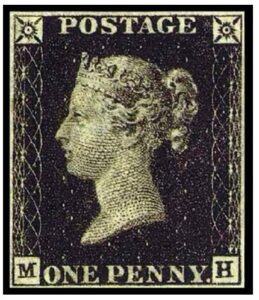
The man who came up with the adhesive stamp was given a knighthood, just because he thought of the stamp!
It all goes back to “letter carriers”, they took letters around London and there were all sorts of delays and other problems.
Therefore, in 1660 Charles II decided to solve the problem, he introduced the General Post Office and he put a guy called Henry Bishop in charge. Henry soon realised that to make the system work they had to record the movement of post, and so we got the postmark.
The King gave him the title of Postmaster General, for a simple reason, to have someone to blame for the postal delays!
Blakes solution was to put a mark on each letter showing the time it was sent, it was called the London Bishop Mark. It was a small circle, bisected horizontally, with the month abbreviated to two letters, in the upper half and the day of the month in the lower half.
He said:
“A stamp is invented, that is put upon every letter showing the day of the month that every letter comes to this office, so that no letter Carrier may dare to detain a letter from post to post.”
It worked, however, intriguingly by the 1800s the costs had grown so much that letters had become single folded pieces of paper, with the address on the other side, as an envelope would increase the cost. There were by now many different ways that people got around paying.
The system wasn’t working, communications were failing, something better was needed!
Up stepped a school master, yes, a school master, Rowland Hill, he proposed an adhesive stamp, that people bought in advance, then attached to their letter.
It worked!
Consequently, on May 6, 1840 the first stamp came out, it was the famous Penny Black. It was black and white with an image of Queen Victoria’s head and worth one penny. Queen Victoria was so impressed that she gave him a knighthood! Then she went further and made him Postmaster General, there he based postal charges on weight rather than, as before, size.
These ideas seem natural today, however, at that time they revolutionized daily life and were then copied by countries all over the world.
Isn’t history interesting?
10 questions to discuss:
- Pre-Post Office System: Before Charles II established the General Post Office, how were letters typically delivered in London, and what were some of the major problems with that system?
- Impact of Postmarks: How did the introduction of the “London Bishop Mark” improve record-keeping and accountability within the postal system?
- Cost Implications: How did the escalating cost of postage in the 1800s lead to changes in letter format and contribute to people seeking ways to avoid paying?
- Rowland Hill’s Background: Was there anything in Rowland Hill’s experience as a schoolmaster that might have influenced his approach to solving the postal communication problems?
- Penny Black Design: Beyond the Queen’s image, did the Penny Black incorporate any other security features or design elements to prevent misuse or counterfeiting?
- Public Reception: How did the public initially react to the introduction of the Penny Black, and were there any concerns or resistance to adopting the new system?
- Global Influence: Can you provide specific examples of countries that quickly adopted the adhesive stamp concept after the success of the Penny Black?
- Beyond Rowland Hill: Were there any other individuals or innovations that played a significant role in refining or expanding the use of postage stamps?
- Evolution of Postal Services: How did the invention of the postage stamp contribute to the broader development of modern postal services and communication infrastructure?
- Legacy of the Penny Black: What is the historical and cultural significance of the Penny Black today, and is it still relevant in the modern era of digital communication?
These questions explore the context, challenges, and solutions surrounding the invention of the postage stamp.
For more on this click on:

